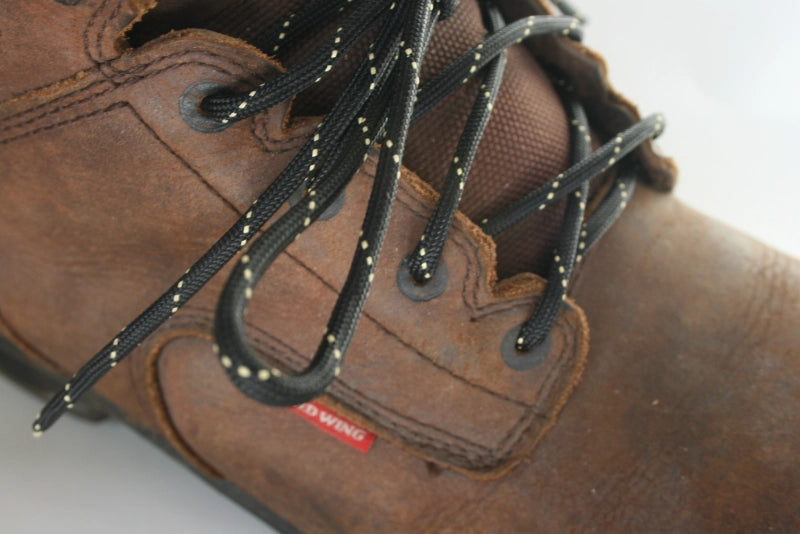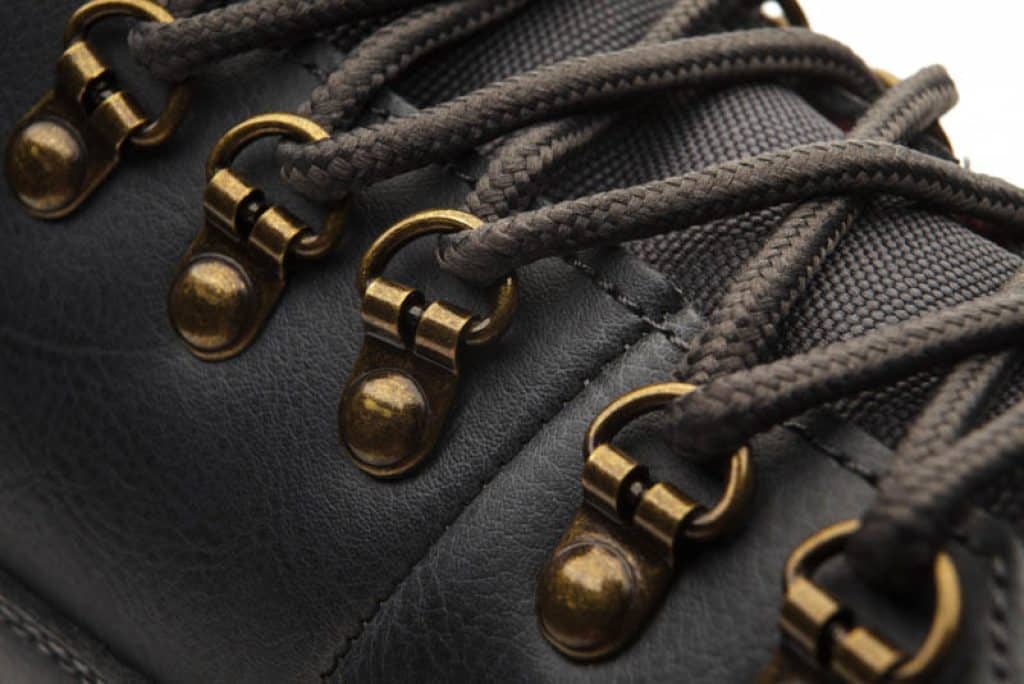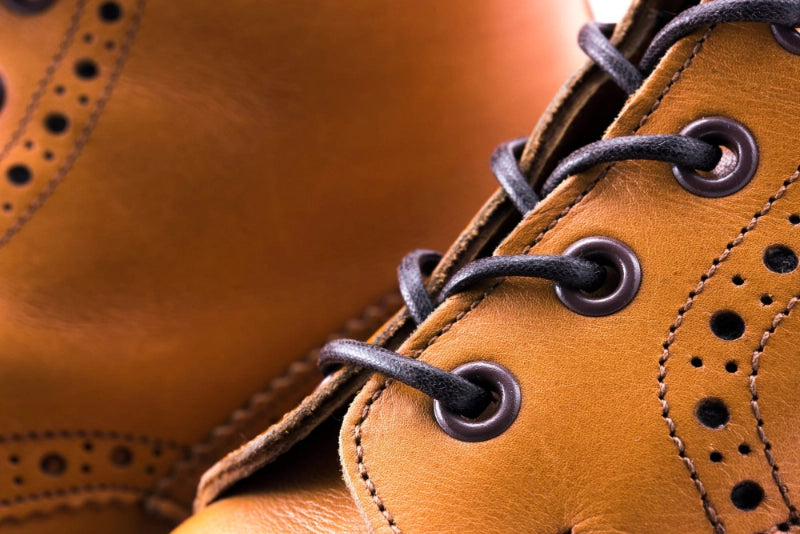1. Introduction
If you need reliable boot laces for work, hiking, or fashion, this guide can help you choose. We'll talk about materials, wax treatments for durability, sizing, shape, and color combinations.
Where did we source information for this buyer’s guide?
We combed through primary research to draw our conclusions. This includes articles like "Aramid Fibers - An Overview" by Jhassal 2022, "Physical Properties of Textile Fibres" by Morton and Heale, Research from the UK National Engineering Laboratory and insights from the book "Handbook Of Fiber Rope Technology" by H. A. Mc Kenna et al. (2004) among other sources.
Contents
1. Introduction
2. The Best Boot Lace Materials
2.1 Leather Boot Laces
2.2 Kevlar Boot Laces
2.3 Ultra High Molecular Weight Polyethylene (UHMWPE) Boot Laces
2.4 Polyester Boot Laces
2.5 Cotton Boot Laces
2.6 Paracord Boot Laces
3. Boot Lace Shape
4. Boot Lace Length
4.1 Standard Boot Lace Lengths
4.2 Complete Boot Lace Length Chart
5. Boot Lace Width
6. Waxed Laces
7. Choosing the Right Boot Lace Color
2. The Best Boot Lace Materials
As we evaluated the available options for boot lace materials. Here's how we determined the best, and the rest:
- How well do they stay tied? Using information from the National Engineering Library, we assessed each material's ability to hold knots securely, ensuring your laces stay tied during various activities.
- Material strength: The tensile strength and abrasion resistance of each material to find out how well it would withstand regular wear and tear.
- Water Resistance: How well each material repels moisture to avoid weakening or rotting.
- Environmental Resistance: How the materials hold up against factors like UV radiation, chemicals, and harsh conditions.
- Special Mentions: Unique properties of each material, such as fire resistance and color retention.
2.1 Leather Boot Laces
Leather boot laces are a stylistic choice. They give a timeless look and are easy to cut to size. As far as performance in heavy duty footwear, they leave something to be desired.

Stylish leather boot laces
Do Leather Boot Laces Stay Tied?
The smooth surface and natural stretchiness of leather makes for knots that easily come untied. Anyone who has worn a pair of boat shoes on dry land knows this struggle.
How strong are leather boot laces?
Leather laces can endure some regular wear but they’ll break with constant bending or heavy stress. What's more, the tanning and treatment process can weaken them (Sharphouse 34-69).
Are Leather boot laces Waterproof?
Leather laces absorb water which can leave them vulnerable to rot if stored wet. It also means they’ll freeze in the winter which can weaken them further, or make them difficult to untie.
2.2 Kevlar Boot Laces
Kevlar, also known as “Para-Aramid” or "Aramid” is a good material choice for tough-as-nails boot laces. Kevlar is very strong for its weight. It can resist abrasions well. Kevlar boot laces miss the mark under prolonged sun exposure and in wet environments. Find an in-depth look at the pros and cons of Kevlar Boot Laces here. As a summary, here's a breakdown of how Kevlar boot laces perform:
Do Kevlar Boot Laces Stay Tied?
Knots are a point of weakness for Kevlar boot laces. The Fibers that make up Kevlar laces are stiffer than other materials like polyester, cotton, or UHMWPE. This means Kevlar boot laces tend to resist knots and untie. Manufacturers can fix this by mixing the Kevlar with Polyester or nylon. This helps the laces stay tied but reduces their strength.
How strong are Kevlar Boot Laces?
Strength is where Kevlar boot laces shine. Kevlar has a higher strength-to-weight ratio than steel or carbon fiber. It's one of the strongest synthetic materials in the world (Giannopoulos and Burgoyne 2009).
Are Kevlar Boot Laces Waterproof?
Kevlar fibers absorb moisture, so they'll rot and degrade if left in prolonged wetness. When Kevlar boot laces get wet and cold, they freeze and become hard to untie. This makes them less suitable for cold weather use (Jassal and Ghosh 2022).
How do Kevlar Boot Laces stand up to the environment?
Kevlar boot laces are resistant to acids and alkaline solutions but they are very sensitive to ultraviolet light. With regular exposure to sunlight, Kevlar boot laces lose as much as 25% of their strength (Chen 2011).
Buyer Beware: Kevlar Blends
Kevlar is an expensive material to work with. Many manufactures get around this by weaving a Kevlar strand into their boot laces. Claims such as "reinforced with Kevlar" or "Made with Kevlar" indicate the use of Kevlar in some proportion less than 100%. These laces stand out with a yellow or black tracer (the Kevlar part). They offer no flame resistance, no abrasion resistance, and little additional tensile strength. Avoid these boot laces and save your money.

Beware: Kevlar Blend Boot Laces
Special mention: Flame Resistance
Kevlar boot laces are famously flame resistant. We’re talking almost "fire-proof". This makes them an excellent choice for fire fighting boots and welding boots.
2.3 Ultra High Molecular Weight Polyethylene (UHMWPE) Boot Laces
Ultra-High Molecular Weight Polyethylene (UHMWPE), AKA Dyneema or Spectra, is a synthetic polymer with astounding strength and resilience. Invented in the 1960s by a German Nobel Prize winning scientist, UHMWPE has revolutionized materials science. The tensile strength and abrasion resistance of UHMWPE surpasses Kevlar and steel. Its resistance to UV radiation, moisture, and acids is better than similar polymers and natural fibers.
UHMWPE is our pick for high-strength boot laces. They have unrivaled resistance to abrasion, the environment, and moisture. While it lacks flame resistance, UHMWPE excels in all other areas, making it ideal for heavy-duty boot laces in most applications.
The US Army has even chosen UHMWPE to replace Kevlar in their latest combat helmets (South 2018). Let's delve into how UHMWPE performs:

UHMWPE Boot Laces
Do UHMWPE Boot Laces Stay Tied?
The textured surface on UHMWPE boot laces generally helps them stay tied. But at a molecular level, UHMWPE fibers are very smooth. This can compromise knots. The best UHMWPE boot laces are treated with a wax coating or a specialized compression weave which creates enough friction to lock the laces together. Waxed UHMWPE Boot Laces hold knots in place better than unwaxed materials.
How strong are UHMWPE Boot Laces?
UHMWPE has a tensile strength exceeding steel and Kevlar. Meanwhile, it's light enough to float on water. Abrasion resistance is a key factor when choosing heavy-duty boot laces and must be considered with strength. A common failure point for boot laces is the abrasion caused by rubbing on boot eyelets and clasps. The smooth fibers of UHMWPE boot laces make them considerably more abrasion resistant than Kevlar (McKenna, Hearle, and O'Hear 2004). Withstanding abrasion means longer lasting boot laces.
Are UHMWPE Boot Laces Waterproof?
Unlike leather or Kevlar, UHMWPE is waterproof. It doesn’t absorb moisture, so it maintains its shape, strength, and integrity when wet. This makes UHMWPE boot laces an excellent option for maritime and outdoor applications.
How Do UHMWPE Boot Laces Stand Up to the Environment?
Compared to other polymers like Kevlar, polyester, and nylon, UHMWPE has a superior resistance to oils, acids and alkalis. Against the sun, all synthetic materials will degrade over time. UHMWPE is no exception here. That said, it holds up to UV radiation better than other polymers (see figure 1 below). It's a great material for laces in outdoor boots.
Relative degradation of polymers with UV exposure. Source: DSM Bioscience

UV Degradation of various ropes materials over time
Caution Flame Resistance
While UHMWPE boot laces have many advantages, flame resistance isn't one of them. UHMWPE will degrade at around 145°C (293°F). This makes them unsuitable for direct exposure to extreme heat or flame. If you're a firefighter or a welder, go for Kevlar.
Special Mention: Color
UHMWPE is generally produced for industrial, military, and maritime applications. This leaves few available color options. UHMWPE is easy to find in black, grey, white, or red. But if you’re looking for a rich brown, or something unique, it may be hard to come by.
2.4 Polyester Boot Laces
Polyester is a common synthetic polymer. It's used in the production of various textiles, including boot laces. Polyester has been popular for its affordability and versatility since its creation in the '40's (Encyclopaedia Britannica, 2021).
It's worth mentioning that polyester boot laces are usually a good price and easy to find. They don't excel in strength or environmental resilience but they have their uses. Polyester boot laces balance affordability with durability, water resistance, and good color options. Polyester laces are a reliable choice for general-purpose footwear.
Do Polyester Boot Laces Stay Tied?
Untreated, round polyester laces tend to release knots easily due to their slight elasticity and smooth texture. Manufactures solve for this by altering the shape of Polyester laces. Flat, or ovalized polyester laces hold knots well. A wax coating will also help them to keep knots tied.
How Strong Are Polyester Boot Laces?
While polyester doesn't match the strength of UHMWPE or Kevlar, it offers a good balance of strength and flexibility. Polyester boot laces are stronger than natural materials like cotton or leather.
Are Polyester Boot Laces Waterproof?
Polyester is very water-resistant and doesn't absorb moisture. This ensures that the laces keep their shape and strength even in wet conditions.
How Do Polyester Boot Laces Stand Up to the Environment?
Polyester resists most chemicals, oils, and acids, though not as well as UHMWPE. Under the sun, polyester lasts longer than Kevlar and nylon, but will degrade faster than UHMWPE (see Figure 1). Polyester's environmental resilience makes it suitable for regular outdoor wear. For hiking boot laces and work boots laces, it's not our first choice.
Caution: Heat Sensitivity
Polyester starts to weaken at around 175–190°C (347–374°F) and can melt at higher temperatures. It's not suitable for direct exposure to extreme heat or open flames.
Special Mention: Color Variety
Unlike UHMWPE, polyester is available in a wide array of colors. It can be easily dyed and holds color well. It's a great choice if you have a specific color in mind.
2.5 Cotton Boot Laces
Cotton is naturally soft, flexible, breathable and gives a classic look. It's a popular choice for boot laces, especially in dress boots like Chukkas.
Cotton boot laces provide a comfortable and traditional choice for footwear. Compared to modern synthetic materials, they aren't as durable or resistant. However, they have a classic aesthetic and feel that some users like. If you want a natural material and a timeless look, cotton laces are a great option.

Waxed Cotton Boot Laces on Dress Boots
Do Cotton Boot Laces Stay Tied?
Cotton laces are textured and fibrous, so they stay tied. Over time, the laces may get smoother and less grippy. Waxed coatings can help cotton laces maintain their grip strength and stay tight. A waxed coating also helps protect cotton laces from the environment.
How Strong Are Cotton Boot Laces?
Cotton provides decent tensile strength for everyday use. As a natural fiber, its strength is about 1/10th that of UHMWPE, or Kevlar and 1/2 of polyester.
Are Cotton Boot Laces Waterproof?
Though it dries quickly with adequate ventilation, cotton is absorbent and won't repel water. This means that cotton boot laces can become wet and heavy when exposed to moisture. Cotton boot laces absorbent quality water makes them vulnerable to mold and mildew. This can weaken the fibers over time. They'll also freeze if wet in cold temperatures. This can further weaken them, and make cotton boot laces difficult to untie in the cold.
How Do Cotton Boot Laces Stand Up to the Environment?
Over time, it will break down when exposed to UV radiation, solvents, or strong acids. It's also biodegradable.
Caution: Heat Sensitivity
Cotton can handle heat well and won't melt, but it can catch fire from an open flame. To avoid danger, keep cotton laces away from heat sources and open flame.
Special Mention: Comfort and Aesthetics
One advantage of cotton boot laces is their soft and comfortable feel. They have a classic, natural look that complements many types of footwear, especially vintage leather boots. Cotton boot laces are available in a variety of colors. A protective wax coating adds an attractive sheen.
2.6 Paracord Boot Laces
"Paracord" boot laces are made from Type III paracord, AKA 550 paracord. They were originally designed for parachute suspension lines. This specific type of paracord gets its name from its ability to support up to 550 pounds of weight. 550 paracord It has a tough nylon sheath and seven inner strands. Each strand is made of two twisted yarns.
Outdoor enthusiasts and survivalists like 550 paracord because it's versatile. It's not as strong as Kevlar or UHMWPE, but the 550lb strength makes it a handy material to have around. Its inner yarns can be taken out and used for fishing, trapping, or mending.

Paracord 550 with 7 strands exposed
Do Paracord Boot Laces Stay Tied?
Paracord laces, due to their nylon construction, are slippery. Yet, their braided design offers texture which helps in retaining knots. Paracord boot laces stay tied as well as Kevlar ones, but not as well as cotton. They're better than polyester on this attribute.
How Strong Are Paracord Boot Laces?
Paracord boot laces can hold 550 lbs thanks to their intertwined strands of nylon. While not as strong as UHMWPE or Kevlar, they're tougher than traditional cotton or polyester laces. The nylon jacket in paracord boot laces is about 3x more abrasion resistant than polyester. It fails long before Kevlar or UHMWPE
Are Paracord Boot Laces Waterproof?
Made of nylon, paracord is naturally water-resistant. While it will absorb some moisture, it dries quickly and doesn't absorb water as cotton does. This makes paracord boot laces an ideal choice for wet environments or outdoor activities.
How Do Paracord Boot Laces Stand Up to the Environment?
Paracord 550 is very resistant to UV radiation. It stands up well to alkalis and most solvents. Acids tend to get the better of this nylon material.
Caution: Heat Sensitivity
While paracord can resist most environmental challenges, it melts at about 250°C. This can be handy if you're sealing an end by burning it. Just be careful around campfires and welding sparks.
Aesthetics
550 Paracord comes in a wide range of colors and styles. The nylon jacket can be easily dyed and it holds color well. Many brands have adopted interesting patterns with color combinations and tracers.
Special Mention: Versatility
Paracord 550 boot laces are a versatile option for outdoor footwear. They are strong, flexible, stylish, and act as a handy survival tool in a pinch.
3. Boot Lace Shape
The shape of boot laces can vary based on three factors: how much natural stretch the shape has, how they look and how well they hold knots when tied.
The three most common boot lace shapes are round, flat, and ovalized. For hiking boots, dress boots, and work boots, round laces are suitable. They provide the acceptable knot retention and excellent durability. The boot structure in hikers and work boots provides ample support for the forefoot such that stretchiness is not required. For running shoes and sneakers, flat and ovalized laces are a better choice. They provide excellent knot retention and their weave spreads any pressure over a higher surface area on the forefoot. They also have some natural degree of stretchiness. These factors minimize excess pressure on the forefoot, which has many benefits for comfort and orthopedic health.
The table below breaks down why one lace shape might be better than another.
 |
Round LacesUse in dress shoes, work boots, hikers, and trail runners. |
Medium-high knot tension |
 |
Flat LacesUse in casual shoes, runners, and sneakers |
Medium knot tension |
 |
Oval LacesUse in Running shoes, performance athletic footwear |
Excellent knot tension |
4. Boot Lace Length
4.1 Standard Boot Lace Lengths
The number of eyelets in your footwear will determine the length of the bootlace. Find the complete guide to boot lace length here. That said, most boots will work well with one of two boot lace lengths:
130cm (51") Boot Laces
- Running shoes with 5-6 pairs of eyelets
- Women's high top hiking boots (usually 6 pairs of eyelets)
- Rubber-bottomed Duck boots
- All other footwear with 5-6 pairs of eyelets
160cm (63") Boot Laces
- 6" work boots
- Men's high-top hiking boots
- All other footwear with 7-8 pairs of eyelets
The Boot Lace Length Chart below gives an overview of lace lengths with examples.
4.2 Complete Boot Lace Length Chart
 |
5 pairs of eyeletsLaces for low-cut hikers, most runners, trail runners |
120-130cm (47-51") shoelace length. |
 |
6 pairs of eyeletsLaces for women's hikers, and 6-inch work boots. |
120-130cm (47-51") shoelace length. |
 |
7-8 pairs of eyeletsLaces for men's hiking boots and 6" work boots |
140-160cm (55-63") shoelace length. |
 |
9-10 pairs of eyeletsLaces for ironworker's boots, and 8-Inch work boots |
170-180cm (67-71") shoelace length |
5. Boot Lace Width
The width of a bootlace affects both how it looks and its compatibility with your boots.
3-4mm diameter boot laces:- This is the most common range for boot laces. They're suitable for the majority of boots including casual, work, and hiking boots.
- These are necessary if your boots have pulley style eyelets. This eyelet style is generally found in high-performance hiking boots and mountaineering boots. If your boots have this eyelet style, opt for laces with 3.5mm diameter or less.
6. Waxed Laces
Waxed boot laces get a thin layer of wax over the outside of the lace during the final stage of manufacturing. This coating enhances knot tightness as the wax grips against itself. It also protects the lace fibers from wear and tear. It adds water resistance, preventing mildew and helping the laces stay clean. Finally, a waxed coating gives a subtle sheen that elevates the look of sneakers and dress shoes.
These benefits make waxed laces a versatile choice for various types of footwear, from work boots to dress shoes. Here's a look at the lace waxing more detail.
7. Choosing the Right Boot Lace Color
Black Boot Laces:Versatility: Black laces work well with a variety of boot colors, making them a safe option for a polished look in various settings.
Black footwear: For black boots, black laces create a seamless and sophisticated appearance. This can make an entire outfit appear more put-together.
Colorful Boots: When your boots are colorful, black laces provide contrast. This allows the vibrant hues of your footwear to take center stage.
Red Boot Laces:The classic pairing of red laces on brown leather boots creates a dynamic and stylish contrast that has stood the test of time. This combination offers a touch of boldness and character to your footwear while maintaining a sophistication and refined appearance. Here's why red laces on brown leather boots are a timeless choice:
The rich, earthy tones of brown leather boots create an elegant foundation for footwear style. Red laces introduce a pop of color that adds visual interest and showcases your attention to detail.
The red and brown color pairing is versatile and adaptable. It works well in both casual and dressier settings. Whether you're wearing jeans or chinos, this combination adds a touch of flair without overpowering your outfit.
Red laces in brown leather boots is a timeless look that has been embraced for generations. Today, the combination evokes a hint of vintage aesthetics.;
Grey Boot Laces:Grey laces are perfect for visually complex boots. If your boots have intricate designs or colors, grey laces act as a neutral base, letting your boots' details stand out.
Use grey laces for matching colors. Grey laces work well with grey boots or boots with grey elements, creating a cohesive look.
For boots made of synthetic materials, grey laces enhance the modern style, blending seamlessly.


